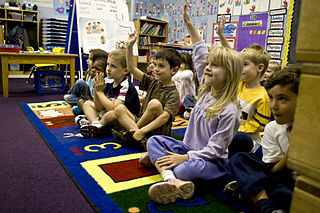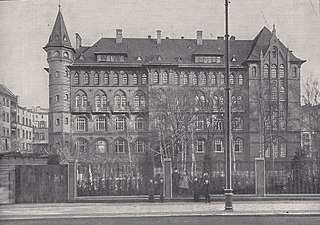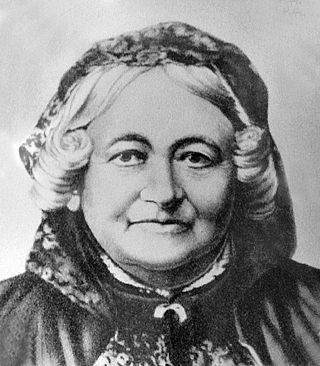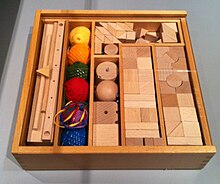
Kindergarten is a preschool educational approach based on playing, singing, practical activities such as drawing, and social interaction as part of the transition from home to school. Such institutions were originally made in the late 18th century in Germany, Bavaria and Alsace to serve children whose parents both worked outside home. The term was coined by German pedagogue Friedrich Fröbel, whose approach globally influenced early-years education. Today, the term is used in many countries to describe a variety of educational institutions and learning spaces for children ranging from two to six years of age, based on a variety of teaching methods.

Friedrich Wilhelm August Fröbel or Froebel was a German pedagogue, a student of Johann Heinrich Pestalozzi, who laid the foundation for modern education based on the recognition that children have unique needs and capabilities. He created the concept of the kindergarten and coined the word, which soon entered the English language as well. He also developed the educational toys known as Froebel gifts.

Susan Elizabeth Blow was an American educator who opened the first successful public kindergarten in the United States. She was known as the "Mother of the Kindergarten."

Toy blocks are wooden, plastic, or foam pieces of various shapes and colors that are used as construction toys. Sometimes, toy blocks depict letters of the alphabet.
Froebel College is one of the four constituent colleges of the University of Roehampton.

Educational toys are objects of play, generally designed for children, which are expected to stimulate learning. They are often intended to meet an educational purpose such as helping a child develop a particular skill or teaching a child about a particular subject. They often simplify, miniaturize, or even model activities and objects used by adults.

Lucy Wheelock was an American early childhood education pioneer within the American kindergarten movement. She began her career by teaching the kindergarten program at Chauncy-Hall School (1879–89). Wheelock was the founder and head of Wheelock Kindergarten Training School, which later became Wheelock College in Boston, Massachusetts, and is now the namesake of Boston University's college of education BU Wheelock. She wrote, lectured, and translated on subjects related to education.

A unit block is a type of standardized wooden toy block for children. Known also as standard unit blocks or kindergarten blocks, these building blocks are common in preschools and some kindergarten classrooms in the United States.

Montessori sensorial materials are materials used in the Montessori classroom to help a child develop and refine their five senses. Use of these materials constitutes the next level of difficulty after those of practical life.

Froebel College of Education was one of five colleges in the Republic of Ireland which was recognised by the Department of Education for the training and education of national school teachers. It was located at Sion Hill, Cross Avenue, Blackrock, Dublin and was run by the Dominican Order.
Bertha Ronge was an activist in the causes of childhood education, women's education and religious freedom. She established the kindergarten movement in England, where she founded the first three kindergartens in London, Manchester (1859) and Leeds (1860). She followed the precepts of Friedrich Fröbel, who advocated the use of structured play activities to promote learning. Bertha Ronge was largely responsible for Fröbel's kindergarten concept gaining a foothold in England.

A Froebel star is a Christmas decoration made of paper, common in Germany. In English it does not have a commonly recognised name; it can be referred to as an Advent star, Danish star, German star, Nordic star, Pennsylvanian star, Polish star, Swedish star, Christmas star, or Froebel star. It is also sometimes called a Moravian star, though the Moravian star is a general category of geometrical shapes and the sixteen tipped piece of origami is specifically called the Froebel star.
Caroline Garrison Bishop was a British advocate for kindergartens. She co-ordinated the introduction of these ideas in London and later opened a college in Birmingham.

The Pestalozzi-Fröbel-Haus was founded in 1882. It was one of the first institutions in Germany that started to train early childhood teachers, as well as one of the first where women could get professional training in Berlin. It believed in teaching children as individuals.

Sophia "Zoe" Benjamin was a pioneer of early childhood education in Australia.

Henriette Goldschmidt (1825–1920) was a German Jewish feminist, pedagogist and social worker. She was one of the founders of the German Women's Association and worked to improve women's rights to access education and employment. As part of that effort, she founded the Society for Family Education and for People's Welfare and the first school offering higher education to women in Germany.

Geometric Exercises in Paper Folding is a book on the mathematics of paper folding. It was written by Indian mathematician T. Sundara Row, first published in India in 1893, and later republished in many other editions. Its topics include paper constructions for regular polygons, symmetry, and algebraic curves. According to historian of mathematics Michael Friedman, it became "one of the main engines of the popularization of folding as a mathematical activity".

Emilie Louise Michaelis (1834–1904) was German-born pioneer of the kindergarten system in England, and a translator, editor, and promoter of Froebel's writings. In 1875, she started one of the first English kindergartens in Croydon, London, and later a training college for teachers, which became Froebel College. She was described as the 'chief exponent of Froebelianism in England' and coined the phrase 'nursery school' in translation from Froebel.
Emily Ronalds was a British social reformer. She supported pioneering cooperative communities, and also had extended theoretical and practical involvement in early childhood education through the formative years of the infant school movement in England.
Beata Doreck was a German educator and first president of the Froebel Society who worked to bring kindergartens to Britain.
















